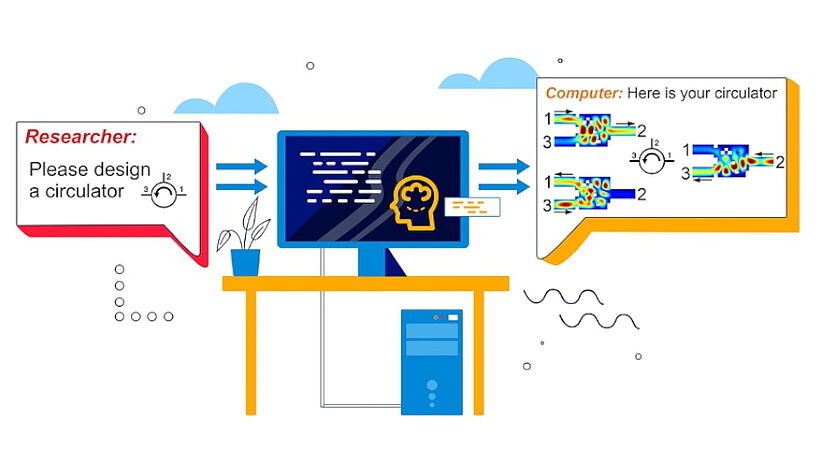Computer designs magnonic devices
11. Mai 2021
The sketch of inverse-design magnonics (© Chloe Kim, Time Illustration Studio)
Magnonic devices have the potential to revolutionize the electronics industry. Qi Wang, Andrii Chumak from University of Vienna and Philipp Pirro from TU Kaiserslautern have largely accelerated the design of more versatile magnonic devices via a feedback-based computational algorithm. Their "inverse-design" of magnonic devices has now been published in Nature Communications.
The field of magnonics offers a new type of low-power information processing, in which magnons, the quanta of spin waves, carry and process data instead of electrons. The end goal of this field is to create magnonic circuits, which would be smaller and more energy-efficient than current electronic ones.
Until recently, the development of a functional magnonic device could take years of trial-and-error. Researchers from the University of Vienna and the TU Kaiserslautern have developed a new computational method to design new devices in a considerably shorter time. Moreover, the efficiency added through this novel inverse design method helps overcome a traditional problem with such devices: they were just suitable for one function only. Now, thanks to the proposed new concept, a primary device could, in principle, be easily modified to perform any function.
Qi Wang, the first author of the study published in Nature Communications, suggested adopting a method that had been used in the field of photonics to magnonics, where the approach has proven to work even better. Three basic principles help to explain the process, as is shown in the figure. First the researchers decide on the functionalities of the device they want to design e.g. a Y-circulator, one of the most common components for separating signal directions in systems engineering. This device guides spin waves from one port into another port according to the circulation condition: wave from port 1 should go into port 2, wave from port 2 into port 3 and from port 3 into port 1. Second, this "task" is translated into a computer language. Finally, the computer generates random structures and optimizes them step-by-step to reach the required functionality. This trial-and-error process is carried out at a very high speed and attains the best solution thanks to an intelligent algorithm. The end result is a design of a working device with the functionalities envisaged by the researchers. This, as Wang from the University of Vienna puts it: "[…] opens the door to large scale magnonic integrated circuits, with any functionality and a high level of complexity".
The proposed approach overcomes the hurdle of designing through experimentation and, instead, emphasizes the importance of researchers’ imagination, who fix the parameters and objectives for the computer-designed devices. An example of this creative process comes from Philipp Pirro, scientist at the TU Kaiserslautern: "With inverse-design one could develop neurons like the ones in our brain, but made out of magnonic elements instead."
The excitement about the possibilities of this approach comes from its capacity to create different functionalities. In their article, the scientists describe how they created a set of different devices. Thus, besides the mentioned Y-circulator, they realized a "multiplexer" that separates a wave with a specific frequency into one channel and a wave of another frequency into another channel. This kind of devices is used in our everyday life to get fast internet. The final demonstrated device is a "non-linear switch" that separates spin waves of different energies: it sends a wave of low power to one output and a wave of high power to another. However, Andrii Chumak, head of the research group at the University of Vienna, points out: "Our study opens the new field of inversed design magnonics with great perspectives. This approach, for now, has been demonstrated numerically only. The next big challenge is to implement it in experiments."
Reflecting on the potential of their findings, Qi Wang jokes: "If I would have had the inverse design approach at the beginning of my studies, I would have finished my PhD way faster!"
Publication in Nature Communications:
Q. Wang, A.V. Chumak, P. Pirro, "Inverse-design magnonic device", Nat. Comm. (2021), DOI: 10.1038/s41467-021-22897-4
Wissenschaftlicher Kontakt
Univ.-Prof. Dr. Andrii Chumak
Nanomagnetismus und MagnonikUniversität Wien
1090 - , Boltzmanngasse 5
+43-1-4277-73910
+43-664-60277-73910
andrii.chumak@univie.ac.at
Rückfragehinweis
Pia Gärtner, MA
Pressebüro der Universität WienUniversität Wien
1010 - Wien, Universitätsring 1
+43-1-4277-17541
pia.gaertner@univie.ac.at
Downloads:
web_06.jpg
Dateigröße: 144,24 KB
